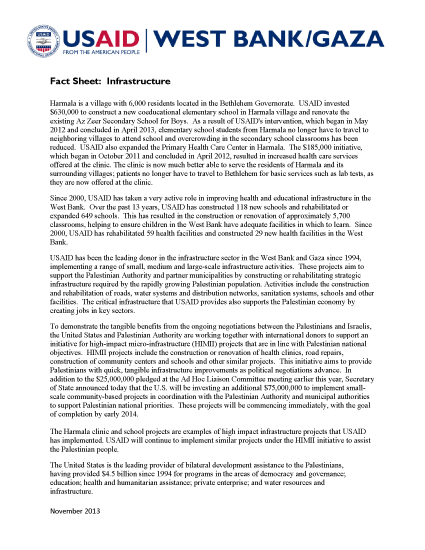Speeches Shim
Harmala is a village with 6,000 residents located in the Bethlehem Governorate. USAID invested $630,000 to construct a new coeducational elementary school in Harmala village and renovate the existing Az Zeer Secondary School for Boys. As a result of USAID's intervention, which began in May 2012 and concluded in April 2013, elementary school students from Harmala no longer have to travel to neighboring villages to attend school and overcrowding in the secondary school classrooms has been reduced. USAID also expanded the Primary Health Care Center in Harmala. The $185,000 initiative, which began in October 2011 and concluded in April 2012, resulted in increased health care services offered at the clinic. The clinic is now much better able to serve the residents of Harmala and its surrounding villages; patients no longer have to travel to Bethlehem for basic services such as lab tests, as they are now offered at the clinic.
Fact Sheet: Infrastructure ![]() (pdf - 90k)
(pdf - 90k)
Since 2000, USAID has taken a very active role in improving health and educational infrastructure in the West Bank. Over the past 13 years, USAID has constructed 118 new schools and rehabilitated or expanded 649 schools. This has resulted in the construction or renovation of approximately 5,700 classrooms, helping to ensure children in the West Bank have adequate facilities in which to learn. Since 2000, USAID has rehabilitated 59 health facilities and constructed 29 new health facilities in the West Bank.
USAID has been the leading donor in the infrastructure sector in the West Bank and Gaza since 1994, implementing a range of small, medium and large-scale infrastructure activities. These projects aim to support the Palestinian Authority and partner municipalities by constructing or rehabilitating strategic infrastructure required by the rapidly growing Palestinian population. Activities include the construction and rehabilitation of roads, water systems and distribution networks, sanitation systems, schools and other facilities. The critical infrastructure that USAID provides also supports the Palestinian economy by creating jobs in key sectors.
To demonstrate the tangible benefits from the ongoing negotiations between the Palestinians and Israelis, the United States and Palestinian Authority are working together with international donors to support an initiative for high-impact micro-infrastructure (HIMII) projects that are in line with Palestinian national objectives. HIMII projects include the construction or renovation of health clinics, road repairs, construction of community centers and schools and other similar projects. This initiative aims to provide Palestinians with quick, tangible infrastructure improvements as political negotiations advance. In addition to the $25,000,000 pledged at the Ad Hoc Liaison Committee meeting earlier this year, Secretary of State announced today that the U.S. will be investing an additional $75,000,000 to implement smallscale community-based projects in coordination with the Palestinian Authority and municipal authorities to support Palestinian national priorities. These projects will be commencing immediately, with the goal of completion by early 2014.
The Harmala clinic and school projects are examples of high impact infrastructure projects that USAID has implemented. USAID will continue to implement similar projects under the HIMII initiative to assist the Palestinian people.
The United States is the leading provider of bilateral development assistance to the Palestinians, having provided $4.5 billion since 1994 for programs in the areas of democracy and governance; education; health and humanitarian assistance; private enterprise; and water resources and infrastructure.
November 2013


Comment
Make a general inquiry or suggest an improvement.